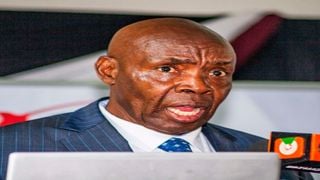
Education Cabinet Secretary Ezekiel Machogu during the release of the universities and colleges placement results at the Kenya School of Government in Nairobi yesterday. More than 200 constituencies may not fully implement their budgets after the NG-CDF Board failed to release all the funds to the constituencies.
| Billy Ogada | Nation Media GroupEducation
Premium
Fees shocker for university students
Students who have qualified for admission to universities and other tertiary institutions will, from Thursday, start applying for funding for their education through the newly created Higher Education Financing Portal.
This effectively marks the end of the automatic government sponsorship of higher education that students have enjoyed over the years, regardless of their economic background. Students now have just one month to apply for funding before the calendar starts in September for universities and technical and vocational education and training (Tvet) institutions.
Funding will be provided through government scholarships, loans and bursaries, with those considered vulnerable and extremely poor receiving more support in the form of scholarships and less in the form of loans.
Those who fall into the needy and less needy categories will receive less in the form of scholarships and more in the form of loans.
In addition, students will apply for loans to cover their living expenses during their studies, as they did previously through the Higher Education Loans Board (Helb). All applications for scholarships, loans and bursaries will now be made through the new portal.
Also read: A peep into the life of a sponsored student
Students who miss out on government funding or who do not receive enough funding will have to dig deeper into their pockets to finance their education.
"Since the presidential directive of May 3, 2023 on the introduction [of] the new funding model, the government has developed and finalised the Higher Education Financing Portal to receive applications for scholarships, loans and bursaries for university and Tvet students. Students who require funding must formally apply through the Higher Education Financing Portal," said Education Cabinet Secretary Ezekiel Machogu while announcing the placement results at the Kenya School of Government yesterday.
"I am, therefore, directing vice-chancellors and principals to ensure that admission letters are released by August 2, 2023. This will enable students to apply for loans and bursaries from August 3, 2023 to midnight of August 27, 2023," he said.
The CS said students' level of financial need will be determined through a Means Testing Instrument (MTI), which he described as scientific and reliable.
"However, continuing students will not be affected by this funding model and will continue to receive their funding based on the existing government model," Mr Machogu said.
Of the 2022 Kenya Certificate of Secondary Education (KCSE) students who qualify for placement, Mr Machogu said over 45, 000 university students and 42,000 Tvet students fall under the category of vulnerable and extremely needy and, therefore, qualify for full funding through government bursaries and loans.
Also read:VCs want the rich denied varsity funds
Needy students receive a maximum grant of 82 per cent of the cost of the programme and 18 per cent in the form of a loan. Those in extreme need will receive a maximum grant of 70 per cent of tuition fees and 30 per cent in the form of a loan.
"Students whose households are at the bottom of the pyramid will have equal opportunities to access university and Tvet education through 100 per cent government funding. This means that their households will not be expected to pay anything towards the cost of the programme and the student will also receive maintenance from the loan," said Mr Machogu.
Students in the needy category will receive a maximum grant of 53 per cent of the cost of the programme and a maximum of 40 per cent in the form of a loan. The percentages will also vary according to individual assessments in the MTI.
The amount of support a student receives also depends on the cost of the programme to which they are admitted. Universities have different costs for different courses. They were required to declare the costs before students applied for placement by the Kenya Universities and Colleges Central Placement Service (KUCCPS). Universities were also required to give a 15 per cent discount on the cost of all programmes.
For example, a degree in medicine will cost Sh612,000 at Kenyatta University (KU), Sh461,210 at Kisii University, Sh612,000 at Moi University and Sh539,750 at the University of Nairobi (UoN).
A pharmacy degree at KU costs Sh428,000 and Sh418,710 at Kisii University. UoN has put the cost at Sh413,950. Students of dental surgery at Moi University will pay Sh612,000 while UoN charges Sh521,050 for the course.
A Bachelor of Arts is the least expensive of all the universities. It costs Sh153,000 per year at KU, Sh122,485 at Kisii University, Sh153,000 at Moi and Sh160,653 at UoN.
The placement and funding model was a joint effort by KUCCPS, Helb and the Universities Fund. The CEO at Helb, Mr Charles Ringera, said the model will enhance equity in higher education funding as opposed to the previous system, which was based on equality.
In the old system, students applied only to Helb for student loans, while the University Fund dealt with the universities. It disbursed the capitation grant directly to the institutions using the differentiated unit cost, which depends on the cost of a programme.
Meanwhile, the release of the results was met with disappointment by students who were not placed in their preferred programmes or institutions.
However, KUCCPS chief executive Agnes Mercy Wahome said the placement was purely based on choice and merit.
"I am disappointed and confused. What could have happened or what can we do? My son got [an A grade of 84 points]. He was placed for the Diploma in Medical Engineering at the Technical University of Mombasa,” lamented a parent.





